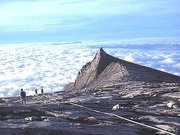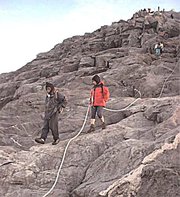Mount Kinabalu
|
|
Template:Mtnbox start Template:Mtnbox coor dm Template:Mtnbox climb Template:Mtnbox finish
Situated in Malaysia, Mount Kinabalu is Southeast Asia's third highest mountain behind Hkakabo Razi in Myanmar and Puncak Jaya in Indonesia, at 4095 m above sea level.
The main peak of the mountain can be climbed by a person of normal health, and requires no mountaineering equipment. Other peaks along the massif, however, require rock climbing skills.
The mountain is contained within a state (formerly national) park, and features a large variety of flora, including wild pitcher plants and orchids.
Mount Kinabalu is most easily reached from Kota Kinabalu, the administrative capital of Sabah. Huts within Kinabalu State Park can be reserved by telephoning the park's authority.
Climbing route
Pitcher_plant_mt_kinabalu.jpg
A typical ascent of the mountain starts at the base camp where a local guide must be hired. All tourists should have a guide: it is an essential safety precaution. In 2002, two teenage tourists were separated from their guide near the top by fog and were found dead from exposure to the elements a day later, after the mountain top was closed for a thorough search. It is advisable to wear strong, well fitting walking boots with two pairs of thick socks to reduce blistering. One should take warm and waterproof clothing, a flashlight, and two litres of water.
The climbers spend the first night at the base camp, at an altitude of about 1200 metres. A 2 km walk the next day to the Park gate commences the start of the 6 km ascent to a small base "hut" at around 3,000 metres. Generally, young and fit person should be able to do this in 3 hours. Older and people that are less fit can take up to 8 hours. The walk tends to be difficult, averaging 1 step up for every 2 steps horizontally, through thick woods. The climb for the moment will be hot and humid, except in cases of rain.
Since there are no roads, porters have to bring 30 kilogram supplies on their back to the hut on foot. Ironically, although many are old women, they tend to reach the hut much faster than the tourists. From here, it is slightly monotonous, until 10 minutes before the hut where the sound of a loud waterfall is heard. Hot food and beverages are available at the hut - if tourists arrive early enough they may have heated rooms.
The final 1,000 metre ascent, covering 2.5 km, should start at 3 am the next day and will take three hours, and is usually collected as one group, even as strangers. It will be dark, the path is very narrow and steep, and a flashlight is essential for this final ascent. A lack of caution will probably result in twisted ankles. At the start, the hundred or more climbers and guides tend to be all together in one long line, so separation is difficult. A thick guide rope that one holds onto will aid the climb. The slope of the mountain after this tends to be very steep, almost to the point of being vertical. Vegetation also becomes increasingly sparse during the last 1,000 metres, and the soil is more rocky, until a certain altitude, solid rock.
Once on the solid rock, the effects of altitude will be apparent for many some climbers as some people suffer from altitude sickness and should return immediately to the bottom of the mountain, and as breathing and any further movement is increasingly difficult. The lights of Kota Kinabalu 60 km away should be visible at this stage of the route. Eventually, the route should finish around 6 am; a metal plaque announces the summit just in time for dawn.
A typical descent from the summit is quick but is often equally painful as the ascent: knee joints, ankle joints and toes tend to suffer as the climbers descend 3,000 metres in five hours.
Tales
Some believe Kina-balu means Chinese widow, from the word "China" and "Balu" malay word for widow. An alternative derivation is from Kadazan dusun phrase Aki Nabalu meeting "The revered place of dead". [1] (http://www.infosabah.com.my/sabah/mtk/mtk.htm)
External links
- Conquering Mt Kinabalu (http://www.cuti.com.my/album/index.php?cat=8)
- Molon's Mount Kinabalu photo gallery (http://www.molon.de/galleries/Malaysia/Sabah/Kinabalu/)


